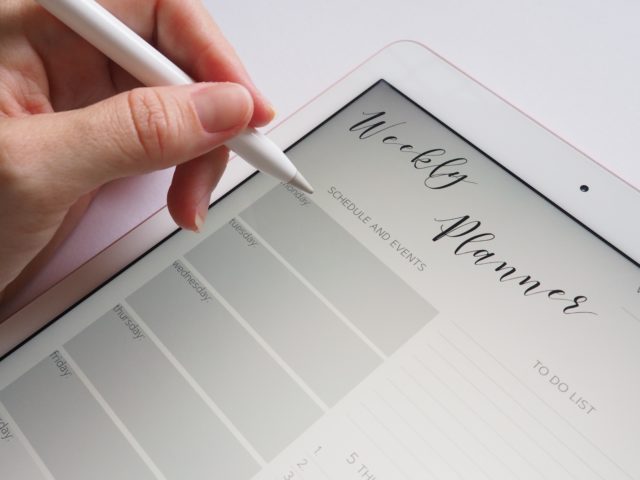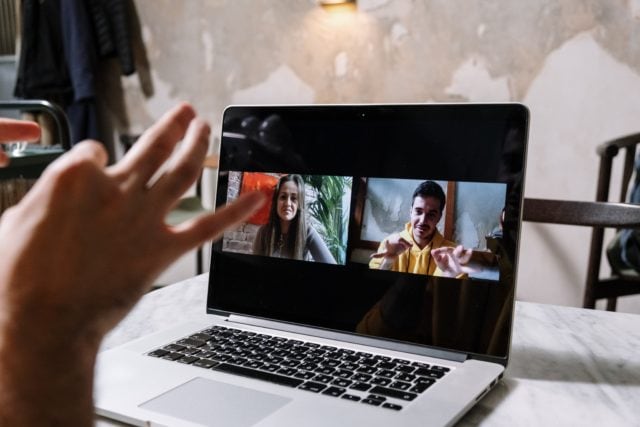
If you’ve never worked from home before it can be a challenge to stay focused and productive. Luckily for you, anyone can be focused and productive at home.
I’ve worked from home for over a decade and have helped thousands of people make the transition from the office building to the home office. Below you will find the five best practices for staying focused and productive when working from home.
My Story of How I Started Working From Home
In 2009, I started working remotely for the first time on a part-time basis. At first, it was one a day a week where I’d be home and the rest of the week at the office.
This is when it was uncommon and many of the best practices around WFH hadn’t been developed yet. So I had to discover on my own how to be productive and get stuff done at home.
At first, I failed miserably. I thought remote work would be easy but I’ve found it hard to get focused work done and at times I felt lost. My co-workers weren’t easily accessible on the days I was home so I was left to my own devices many times.
My boss started to notice my lack of productivity too and casually mentioned it to me one time over lunch. If I didn’t change his perception, I would have to go back to the office full-time.
So I was determined to figure out how you can be productive while working from home. After hundreds of experiments and hours of trying different things, I eventually figured it out. It got to the point where I was more productive at home than when I was at the office. My boss begged me to work from home more often because I was getting more work done from my bedroom than my corner office.
Over the years I’ve shared some of the lessons I’ve learned on the Asian Efficiency blog and in this post I’ll be sharing the best of the best productivity strategies for working from home and staying productive.
I truly believe everyone can work from home and be productive when you have the right habits in place. Remote work doesn’t require more discipline but it does require a more thoughtful approach to how you tackle the week and your days. If you can master that, in the long-term, you will be more productive at home than you were at the office. This is especially true now with COVID-19.
Let’s dive in and get you to become a productive worker with the following productivity tips.
The 5 Most Important Habits for Working From Home and Staying Productive
When it comes to staying focused and being productive while working from home, it comes down to five key habits:
- Create Your Ideal Schedule
- The Rule of 3
- Planning The Night Before
- Overcommunicate
- The Logoff Routine
Let me explain each in more detail so you will be efficient working remotely.
1. Create Your Ideal Schedule

When you work at the office, you’re often given a structure of what your workday will look like. You come in at 9am and leave at 5pm. In between, you have a few meetings, a lunch break, and you get a few things done here and there. The time you need to get work done is oftentimes given to you.
Pretty simple, right?
When you start working remotely, you lose this structure. You roll out of bed, commute for 6 seconds and you’re at work. It’s now up to you to figure out when you start working, when to eat lunch, when you stop working, and how much needs to be done in a given day. This is one of the biggest problems you face when you work remotely for the first time. They have no sense of structure and feel like they have to work 24/7 to keep up with the demand.
That’s why the first step to being organized at home is to create a structure for your day. This will be your ideal schedule.
You want to mimic the same hours you were working at the office at home. So if you came in at 9am at the office, you start working at home at 9am too. If you left the office at 5pm, you also stop working at home at the same time.
The more you can make this a routine, the easier it will be to stick to it and create efficiencies throughout your day. When you know that you always start and end at the same time, it’s easier to plan and schedule activities outside of work. For example, when you’ll be able to drop off the kids or go play tennis with co-workers outside of work. Take advantage of the fact that you have more control over your day and hours than before! How you manage your time is, to a certain degree, more under your control now.
Here are a couple of questions you need to ask yourself:
- When will I start my day?
- When will I end my day?
- When and where will I eat lunch?
- How can I schedule at least 1 hour of uninterrupted time per day to get my important work done?
One tip I would add to this is to schedule your breaks as much as possible. When you’re in work mode and your focus is on getting as much work done as possible, it becomes easy to skip breaks and run yourself into the ground. Don’t do that. Add a break here and there onto your schedule to prevent that from happening. Your productivity will be the highest when you’re able to have breaks in between tasks – especially between the deep work tasks you might have.
Now that you work from home, create your ideal schedule. Stick to it for a week and see how it works for you. You can always tweak it moving forward.
2. The Rule of 3
Anytime you start work mode, you should be able to know right away what your three most important priorities are for the day. We call this the Rule of 3.
When you can accomplish three big tasks in a day, that would be considered a productive day.
You might have a lot more tasks on your to-do list but not all of them will be of equal importance or priority. As we like to say, when everything looks important, nothing truly is.
That’s why it’s important to always prioritize your to-do list. Ideally, the night before (see my next point). We’re big fans of the Eat That Frog strategy. Simply put, tackle your highest priority task first thing in the morning. Do this every day and you’ll have productive days and weeks ahead of you.
This is especially true when you’re working from home because that’s how you’ll be evaluated. Bosses and managers cannot monitor you all the time and see if you’re working or not. In remote settings, that could be considered a disadvantage for the upper management team. Since they cannot see you, the only way for them to evaluate your performance is if you hit your numbers and accomplish the outcomes that they’re looking for.
That’s why it’s key that you know what your daily priorities are and that you’re moving them forward.
Based on my own experience and the clients we’ve worked with, completing three big tasks for the day is something you can be proud of. This typically doesn’t include routine tasks. We’re talking things that move projects forward, tasks that get you closer to your goals, and oftentimes it’s things you don’t want to do but know are important. At the end of the day, that’s how management will know if you got stuff done or not.
Follow the Rule of 3 every day and you’ll be one productive human being!
3. Planning The Night Before
To layer on top of the Rule of 3, we recommend that you figure out your Rule of 3 the night before. Planning your day the night before is something you’ve might have heard before…but have you implemented it?
It’s such an easy thing to do but one of the most powerful habits to have. It allows you to start your day with a focused mindset. You don’t have to scramble in the morning, make yourself a target to get easily distracted, and run into your best friend called “procrastination”.
Working remotely requires you to focus more on what’s important and disregard the rest. Make sure that you always know what your top priorities are so you don’t lose sight of what moves the needle forward. It’s easy to get overwhelmed and bombarded with things to do but at the end of the day you get rewarded for pushing the important work goals and priorities forward. With this tip, you’ll be able to prepare yourself ahead of time and be ready when you’re getting ready for work mode.
When you know your Rule of 3 and have planned it the night before, you can sit down at your desk the next morning and instantly get focused work done. A good idea to make this a habit is to set up reminders for yourself to do this or to add this step to another habit you’re already doing (some people call this “habit stacking“).
Start planning your tomorrow before you go to stop work for the day or before you go to bed. Try it and see what a difference it makes.
4. Overcommunicate

In a remote company what tends to happen is that collaboration amongst people starts to vanish. Sharing ideas and collaboration used to be easy now becomes challenging because you’re not in the same office anymore.
The same goes for setting up meetings. You used to be able to walk in and schedule a meeting but now everything has to be done via email and when you involve multiple people it can lead to lots of email chain…that eventually leads to nowhere but an overflowing inbox.
When you lose that social in-person aspect, people start to work alone on tasks and work in silos. Everyone gets assigned a task and is expected to get them done without much collaboration.
This leads to under communication in teams and in the workplace. Assumptions get made and miscommunication rises which can lead to more friction, production delays, and in some cases frustration amongst people.
At Asian Efficiency we’ve discovered that over-communication is one of the best habits a remote employee can have. Since you cannot read someone’s mind over a faceless Zoom meeting, it’s best that everyone overshares what’s going on.
As we like to say: when in doubt, say it.
We encourage everyone to share, share and share. This could be things like:
- Going away for lunch
- You’re stuck on a task
- You’ll be running errands and are away from the computer between 2-4pm
- You’re not feeling well
- When you’re planning to be taking time off from work
- Where you might foresee challenges and roadblocks for the team
The more everyone is aware of what’s going on with you, the easier it is for everyone else to support you and move things forward.
When in doubt, say it.
5. The Logoff Routine
Have you recently checked your work email late at night in bed?
Chances are, you’re not the only one.
New remote workers find it challenging to know when to stop working. At the office, you have an easy boundary when you stop. When you see co-workers leaving the office it’s a reminder for you to wrap things up.
But when you’re working at home, there’s no such thing. What happens is that people working from home keep working longer hours than they did at the office.
This could lead to more stress, fatigue, and over time in burnout.
That’s why it’s so important to have boundaries so you can achieve a work-life balance and take care of yourself. Specifically, a boundary when you stop working. Every day I start my day at 8am and end it at 4pm. When four o’clock rolls around I don’t immediately stop working. I have a specific routine I go through before I wrap things up. I like to call this the Logoff Routine. Here’s what it is:
- I try to finish up my tasks. If I can’t finish it, I’ll write down notes of my current thoughts and what I think are the next steps to finish it.
- I clear my desk and tidy up the home office (we call this Clearing To Neutral).
- I look at my calendar for the next day to see how many meetings I have and time available to do important work
- I then plan for the next day and determine my Rule of 3.
- I create my todo list for tomorrow
And that’s it. It usually takes me about 10-15 minutes to do this. By the time I’m done, I know exactly what to do the next day and I feel accomplished about my day. No matter what happens next, I know that I can shut down for work and be present with what’s coming up next.
This allows me to prevent working late hours and bringing work into the bedroom. Self-care is important for remote workers yet it’s not talked about enough.
Implement the Logoff Routine today and see how powerful it is.
Next Action
Now you know the five most important habits for being productive while working from home. Pick one to implement today that resonates with you and see how easy it is.
I don’t recommend that you implement all five at the same time. It’s best to pick one, make it a habit and then move on to the next one.
If you’re looking for more help and resources on how to be productive working from home, check out our guide on how to set up a productive home office.
We also have a free online training that you can attend on how to be productive working from home. It’s free and available (morning, afternoon, and evening). Check it out here while it’s available for a limited time.
